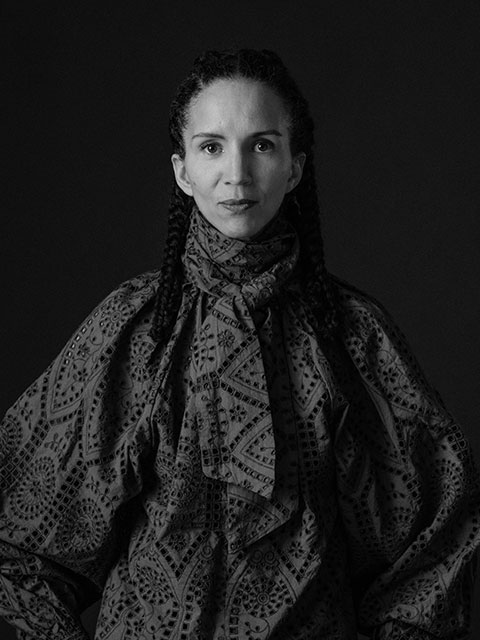In March 1850 Louis Agassiz (1870–1873) commissioned J.T. Zealy (1812–1893) to photograph enslaved people on the Edgehill plantation in South Carolina, USA. Utilising the technology of photography as part of his eugenics campaign, Agassiz chose seven enslaved individuals – Alfred, Fassena, Jem, Jack, and his daughter Drana, Renty and his daughter Delia. In an attempt to prove his theories of black inferiority, the seven were then forced to pose in Zealy’s studio.
Agassiz’s son, Alexander, donated these images in 1858 to the Peabody Museum of Archaeology and Ethnography at Harvard University, USA, where Agassiz was a professor and Founding Director of the Museum of Comparative Zoology. Since they were rediscovered in the Museum in the late 1970s these works have been the centre of urgent debates about photography ever since. To reclaim their freedom, which was never granted during their lifetimes, Tamara Lanier, the descendant of Renty, filed a lawsuit in March 2019 against Harvard University to repatriate the daguerreotypes of her ancestors held in the collection.
Following the realisation of the works depicting Renty and Delia, Huber completed the series, producing five further portraits that comprise Tailoring Freedom (2021-22). The series addresses the problematic legacy of the naturalist Agassiz and adopts Huber’s notion of using art to heal colonial traumas. In this series, Huber weaves together her signature stapling method and photography for the first time. In the work depicting Drana for example, Huber reproduced and printed the photograph on wood, ‘dressing’ Drana in a dress inspired by Sojourner Truth, an abolitionist and women’s rights activist.
These works were co-commissioned by The Power Plant Contemporary Art Gallery, Toronto; Autograph, London; Turku Art Museum, Finland; and Kunstinstituut Melly, Rotterdam.

is a Helsinki-based, multidisciplinary visual artist-researcher of Swiss-Haitian heritage. Sensitive to the subtle threads connecting history and the present, she uses and responds to archival material within a layered creative practice that encompasses performance-based interventions, video, photography, and collaborations.
Huber frequently reclaims – aware of its symbolic significance – the compressed-air staple gun as an artistic ‘weapon’, tapping into its potential to renegotiate unequal power dynamics. She is known for her artistic research contribution to the Demounting Louis Agassiz campaign which aims to dismantle the glaciologist’s lesser-known but contentious racist heritage. Huber also often works in a creative partnership with artist Petri Saarikko with whom she initiated the long-term project Remedies Universe.
Huber holds an MA in visual culture from the Aalto University and is presently undertaking a practice-based PhD at Zurich University of the Arts. Huber has had numerous solo presentations, artist residencies and participated in international exhibitions and festivals, including the 56th Venice Biennial in 2015. In 2021 Huber’s solo exhibition tour YOU NAME IT began at Kunstinstituut Melly in Rotterdam and continues to The Power Plant Contemporary Art Gallery in Toronto; Autograph in London in 2022/23; and Turku Art Museum in Finland in 2023. In 2018 the Arts Promotion Centre Finland awarded Huber the State Art Award in the category visual arts and in 2022 she received a multi-year artist grant.
Banner image: Sasha Huber, works from Tailoring Freedom, 2021-22. Metal staples on fire burned wood, various dimensions © the artist. Courtesy of / commissioned by The Power Plant Contemporary Art Gallery, Toronto; Autograph, London; Turku Art Museum, Finland; and Kunstinstituut Melly, Rotterdam.
View the commission images: All works © the artist. Courtesy of / commissioned by The Power Plant Contemporary Art Gallery, Toronto; Autograph, London; Turku Art Museum, Finland; and Kunstinstituut Melly, Rotterdam. 1) Sasha Huber, Tailoring Freedom – Jem, 2022. Metal staples and photograph on wood, 49 × 69 cm. Original images courtesy the Peabody Museum of Archaeology and Ethnology, Harvard University (35-5-10/53046). 2) Sasha Huber, Tailoring Freedom – Fassena, 2022. Metal staples and photograph on wood, 49 × 69 cm. Original images courtesy the Peabody Museum of Archaeology and Ethnology, Harvard University (35-5-10/53048). 3) Sasha Huber, Tailoring Freedom – Alfred, 2022. Metal staples and photograph on wood, 49 × 69 cm. Original images courtesy the Peabody Museum of Archaeology and Ethnology, Harvard University (35-5-10/53049). 4) Sasha Huber, Tailoring Freedom – Jack and Drana, 2022. Metal staples on photograph on wood, 97 x 69 cm.
Original images courtesy the Peabody
Museum of Archaeology and Ethnology, Harvard University (Jack, 35-5-10/53043; Drana, 35-5-10/53041).
About the artist: Photo courtesy Sasha Huber.
Autograph is a space to see things differently. Since 1988, we have championed photography that explores issues of race, identity, representation, human rights and social justice, sharing how photographs reflect lived experiences and shape our understanding of ourselves and others.